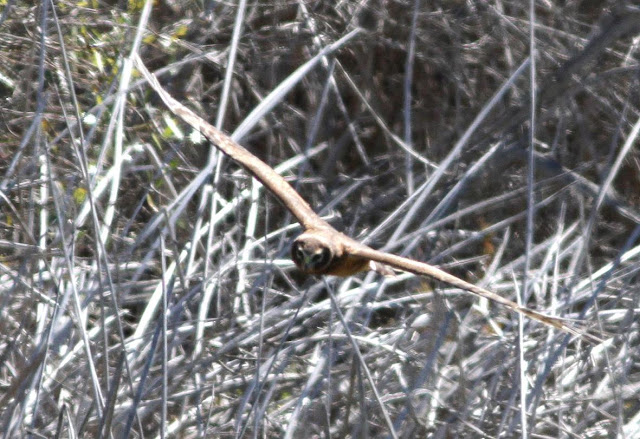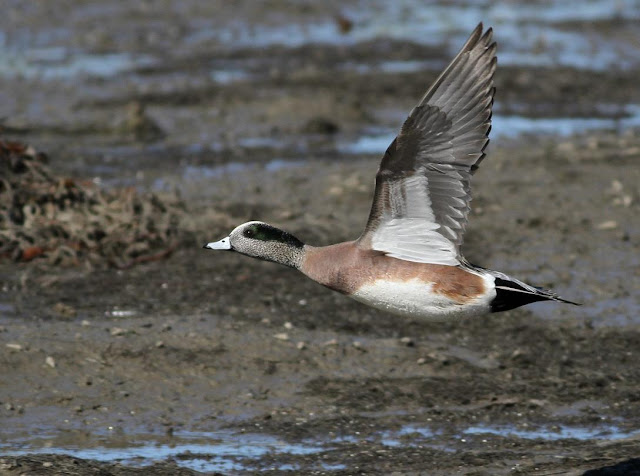Lately, there have been days when it was very difficult
just to find one or two shorebirds or ducks in the tide channel at our lagoon but
it's amazing what a difference a day can make. I had visited the San Elijo
Lagoon on the northern Cardiff side first but saw only a lone Western Grebe and a few Willets
probing the mud flats for prey. Wanting to check and see if there were more bird
subjects to photograph over at Rios East, I headed to the Solana Beach side of
our lagoon. I was rewarded with a view of the tide channel near the
freeway completely loaded with a wonderful variety of shorebirds and ducks.
First stop was at the Cardiff side of the San Elijo Lagoon on the Nature Center trail and I spot a
lone Western Grebe swimming by the first lookout by the visitor center.
A Northern Harrier flies in. What a
beautifully marked female Harrier. She doesn't stay long and heads towards the
Solana Beach side of the lagoon. I decide that is where
I am going to go too.
Arriving on the Solana Beach side of the lagoon, I take
the Rios trail east towards the freeway. As soon as I get close to the tide
channel, I spot an Eared Grebe. LOL... They always appear to have a surprised
look. I think it's those orange round bulls-eye-looking eyes that give them that
look.
Slightly further east, the beautiful sight of shorebirds flying
in. Looks like a flock of Short-billed Dowitchers.
What a great sight to see! So many birds enjoying our
beautiful lagoon. Can you spot how many types of ducks and shorebirds are in
this photo?
A male Mallard struts by showing off his beautiful
metallic-colored plumage.
Another male dries his wings after a bath.
Mallards may be the most common duck in the world but I think he
is one of the most beautiful of all the ducks.
A male Green-winged Teal is seen on the mud flats.
A female Green-winged Teal is close by. Green-winged
Teal, Anas crecca are the smallest of the Teal
ducks measuring only 14 inches long with a wingspan of
23 inches.
A pair of Blue-winged Teal swims by. Looks like a juvenile
is tagging along.
High up in the sky, I spot a Red-tailed Hawk checking out
the target rich lagoon.
The male Blue-winged Teal flaps in an agitated display. He is easy
to identify by the white crescent on his face.
The presence of a hawk makes many of the visitors a little
nervous. Here a pair of Northern Pintails look as though they are going to fly.
A male American Wigeon sits up and flaps his wings in a
display adding to the tension.
The Pintails are quite nervous and they take flight. When
the migrating ducks arrive they are quite guarded for a few weeks and anything
can trigger them to take flight. Soon they seem to settle down and get used to
their surroundings, feeling more confident that no one is going to shoot them here
in the nature reserve.
The male Northern Pintail in breeding plumage leads the way as a young male still in non-breeding plumage follows.
Now a American Wigeon starts her flight.
She takes a few steps and becomes airborne.
The male American Wigeon follows.
A cute shot of a pair of Northern Pintails. The male is in
front followed by the female. She looks drab compared to the striking looks
of the male.
A Long-billed Curlew flies in. Numenius
americanus measures 23 inches long with a wingspan of 35 inches.
His long bill is perfectly designed to poke into the mud
flats and find the crabs. Here he has himself a little crab snack.
He takes the muddy crab to the water and dips it to clean
off the mud.
His snack cleaned, he proceeds to quickly swallow it.
A while later, I find the Curlew focused on something in the
little tide pool.
Wow, he grabs for a fish but it flips out of his grasp.
With his super long bill, he tries to grab the slimy fish.
The fish escapes between his legs and gets back into the
tide pool.
The Curlew is not giving up on this nice sized snack and grabs
again for the fish.
LOL... try using a super long chopstick to pick up a slimy
wiggling fish and you can see how difficult it must be for this Curlew! How is
he going to manage this?
The Curlew grabs and it escapes again. Now they appear to
be checking each other out.
Another grab... but it slips out again.
Maybe if he grabbed it belly up?
Nope, the "slippery one" gets away again.
Finally he gets a good grip and the Curlew starts to walk out of the
tide pool .
But nope, the fish wiggles out of his grip.
The Curlew is determined to get his meal.
A good firm grip and once again heading out of the tide
pool.
Looks like he has a good grip this time and his bill is
locked around the gill area of the fish for maximum control, finally managing
to toss it up into his mouth to swallow his prize.
Look at those flashy yellow colored legs. Yes, that is his
name, Greater Yellowlegs. Tringa melanoleuca measures
14 inches long with a wingspan of 28 inches.
What a wonderful walk it has been today to see all the new
visitors to our beautiful lagoon. Here is one last shot showing some Least
Sandpipers flying in as I spot a shorebird that may be a
life bird for me... a Curlew Sandpiper? Is it just wishful thinking? I will have to get one of our experts
to verify this bird! Time for me to head for home.











































I enjoyed your sequence of the Long-billed Curlew.
ReplyDeleteThank you for your comment Lance.
Delete